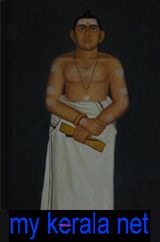






KERALA - a declaration of love towards life
Kerala, located on the south-western coast of Inda, offers an array of features
that explains why it has become a favourite tourist destination.
- Darstellende Kunstformen wie KATHAKALI mit seinen heldenhaften Charakteren, KUTIYATTAM, das 3000 Jahre ale klassische Sanskrit Tanzdrama und NANGIAR KUTTU, die weibliche Soloform dieser Kunstrichtung, TOLPAVA, eine der ältesten zerremoniellen Schattenpuppelspiel-Traditionen auf der Welt mit eigenem Theatergebäude, dem KOOTHU MADAM, innerhalb der der Mutter Gottes Bhagwati geweihten Tempelanlagen und KALAMEZHUTU und THEYYAM, zwei einzigartigen, faszinierenden zeremoniellen Formen praktizierter Kunst.
- KALARIPAYATTU, eine Jahrhunderte alte Kampfkunst, die ästhetische Körperbewegungen, Spiritualität und Kampfähigkeit, die sich von den Vorbildern majestätische Tierarten beseelt sind.
- Einzigartige geographische Merkmale von tropischer Vegetation und Lebensformen mit NATIONALPARKs zur Bewahrung der Naturschätze, den BACKWATRERS, ein System von Kanälen entlang von Palmenhainen und dörflichen Siedlungen, Bergstationen mit atemberaubendem Rundblick zum Entfliehen der Hitze und ruhige Strände zur Entspannung.
- Ein traditionelles System indischer Heilkunst und Lebensweise, AYURVEDA, und eine einzigartige Küche südindischer Nahrungszubereitung.
- Nach der Ernte beginnt die mehrmonatige Zeit der Feste und des Dankes wie das THRISSUR PURAM, Höhepunkte des Ausdrückens von Lebenslust und Lebensfreude, eine Augenweide und ein Ohrenschmaus.